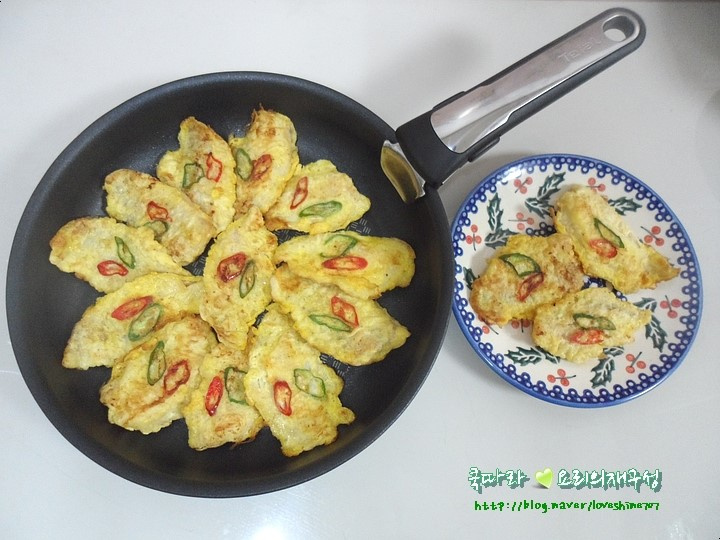Golden Recipe for Deliciously Savory Pollock Jeon (Dongtae Jeon)
Winter Delicacy: Dongtae Jeon – Easy and Beautifully Made

The Lunar New Year is fast approaching, and I’m thrilled to share my secret to making delicious, visually appealing, and incredibly savory Pollock Jeon (Dongtae Jeon). This recipe is perfect for festive occasions and gatherings. Learn how to achieve a crispy exterior and a moist, flavorful interior. Elevate your holiday table with this delightful dish!
Main Ingredients- 1 pack (approx. 300-400g) prepared pollock fillets (dongtae)
- 1 Korean chili pepper (cheongyang)
- 1 red chili pepper
- 4 large eggs
- 5 Tbsp all-purpose flour for coating
- A little sesame oil (for finishing)
- Generous amount of cooking oil
- 1 Tbsp cooking wine (mirin or similar)
- 1 pinch of salt (for egg wash)
Pollock Marinade- A little salt
- A little black pepper
- A little salt
- A little black pepper
Cooking Instructions
Step 1
First, let’s prepare all the ingredients that will make our Dongtae Jeon taste amazing. Gently rinse the pollock fillets under running water and pat them dry. Slice the chili peppers thinly on an angle after removing the seeds.

Step 2
Season the rinsed and dried pollock fillets with a pinch of salt and pepper. Let them marinate for at least 10 minutes. This step is crucial for removing any fishy odor and infusing the pollock with flavor, making your jeon much more delicious.

Step 3
Thinly slice the Korean chili peppers (cheongyang) and red chili peppers diagonally after removing the seeds. This slicing method allows for beautiful garnishes on top of the jeon, adding vibrant color and visual appeal, making the dish look even more appetizing.

Step 4
Crack the eggs into a bowl and whisk them, removing the chalazae (the white stringy bits). Removing the chalazae results in a smoother egg wash, which coats the pollock evenly and improves the overall texture of the jeon. Add 1 tablespoon of cooking wine (like mirin) to eliminate any egg odor, ensuring a clean, fresh taste. Whisk gently to avoid creating too much foam.

Step 5
Use paper towels or a clean kitchen cloth to firmly press down on the marinated pollock fillets, absorbing as much moisture as possible. Excess water can prevent the flour and egg coatings from adhering properly and may cause oil splattering during cooking. Thoroughly dabbing dry is key to a successful jeon.

Step 6
Lightly coat both sides of the dried pollock fillets with all-purpose flour. This flour coating acts as a binder, helping the egg wash to stick better. Be careful not to apply too thick a layer; simply dust them lightly and shake off any excess.

Step 7
Dip the flour-coated pollock fillets into the prepared egg wash, ensuring both sides are well-coated. Gently shake off any excess egg mixture. The egg wash will give the jeon its signature golden color and delicious texture.

Step 8
Heat a generous amount of cooking oil in a frying pan over medium heat. Add about 1 teaspoon of sesame oil for added aroma, but be cautious not to use too much, as it can burn easily. Carefully place the egg-coated pollock fillets into the hot pan, one by one. Avoid overcrowding the pan; cook in batches if necessary to ensure even cooking and easy flipping.

Step 9
Artfully arrange the thinly sliced chili peppers on top of each pollock fillet as they cook. Using both red and green chilies creates a beautiful contrast and adds a festive touch, perfect for holiday meals. Gently press the chilies onto the pollock to ensure they adhere.

Step 10
Cook over medium-low heat until the underside is golden brown and crisp. Carefully flip the jeon using a spatula. You can check if it’s ready to flip by gently lifting an edge. Cook the other side until equally golden brown and the pollock is cooked through. The goal is a crispy exterior and a moist, tender interior.

Step 11
Once cooked, transfer the Dongtae Jeon to a plate and arrange them without overlapping. Letting them cool slightly before stacking prevents them from sticking together and helps maintain their beautiful shape. This also keeps them from becoming soggy. While best enjoyed warm, they are also delicious when cooled.



